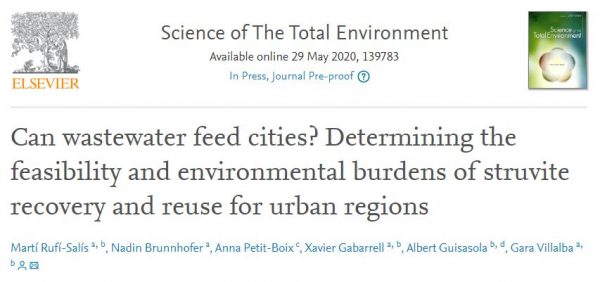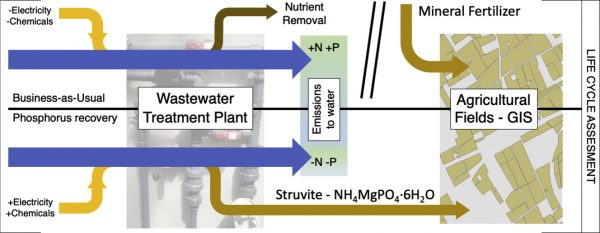Publication in Science of The Total Environment
3 June 2020
See full article: https://doi.org/10.1016/j.scitotenv.2020.139783
Phosphorus (P) resources are decreasing at an alarming rate due to global fertilizer use and insufficient nutrient recovery strategies. Currently, more circular approaches are promoted, such as recovering P from wastewater in the form of struvite. This is especially attractive for urban areas, where there is a growing trend of local crop production and large volumes of wastewater are treated in centralized wastewater treatment plants (WWTPs). This research aims to assess the technical and environmental feasibility of applying a struvite recovery and reuse strategy to meet the P requirements to fertilize the agricultural fields of an urban region. To do so, we analyze the potential P recovery and the environmental impacts of integrating three recovery technologies (REM-NUT®, Ostara® and AirPrex®) in the two biggest WWTPs of the Àrea Metropolitana de Barcelona. The results show that all technologies are able to recover between 5 and 30 times the amount of P required to fertilize the agricultural area of the region annually (36.5 t). As can be expected, including P recovery technologies result in additional impacts per m3 of wastewater due to increased electricity consumption and chemicals required for the struvite precipitation. However, struvite recovery results in less eutrophication potential, especially in the REM-NUT® case, with an average reduction of 5.4 times. On the other hand, Ostara®, that recovers P from the digestate, had the lowest impacts (9 kgCO2eq/kgP), even compared to the production of mineral fertilizer. When we apply our findings to the whole region, we can see that chemical use for struvite precipitation and energy consumption during the wastewater treatment process are the elements with the greatest impact. Thus, choosing the most appropriate technology in the most suitable WWTP is the most efficient strategy to diminish the environmental impacts of the system.
